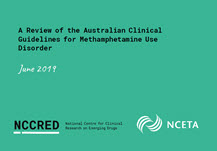A Review of Australian Clinical Guidelines for Methamphetamine Use Disorder
There is widespread concern in Australia regarding increased use of methamphetamine, particularly the potent crystalline form of the drug known as ‘ice’, and the complex physical, mental health and social problems and harms associated with use.
Australia’s National Ice Action Strategy highlights five action areas:
- Support for families and communities
- Targeted prevention
- Investment in treatment and workforce
- Focused law enforcement
- Better research and data.
The role of treatment and other interventions is crucial in addressing methamphetamine-related problems. Treatment for methamphetamine-related problems occurs in a diverse array of settings, including:
- Hospitals
- Alcohol and Other Drug (AOD) specialist services
- Primary and community care
- Correctional services.
Methamphetamine treatment is provided by a wide range of health and human services professionals, such as:
- Emergency department staff
- Nurses
- General practitioners
- AOD workers
- Police
- Social workers
- Psychologists.
Different professional groups and the various settings in which they work require targeted evidence-based support tools and clinical guidelines to inform individual workers’ practice and the delivery of safe, effective, high quality and appropriate treatment services.
NCETA undertook a comprehensive internet search for Australian methamphetamine clinical guidelines to:
- Identify the Australian methamphetamine clinical guidelines available
- Map treatment settings and populations covered
- Assess guidelines against contemporary guideline criteria
- Identify gaps and implications for future guideline development.
The report, A Review of Australian Clinical Guidelines for Methamphetamine Use Disorder presents the findings from these activities and identifies:
- 27 methamphetamine-related Australian clinical guidelines
- the treatment setting and population group addressed in the guidelines
- gaps and strategies to inform future development in this area.
This resource was commissioned by The National Centre for Clinical Research on Emerging Drugs (NCCRED).
